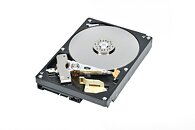Toshiba Electronic Devices & Storage Corporation announces the DT02 7200 RPM 2 TB HDD, designed for desktop, PC computing, gaming and storage applications where performance and reliability are critical. The new DT02 7200 RPM 2 TB HDD delivers higher performance than Toshiba's predecessor and leverages Shingled Magnetic Recording (SMR) Technology. The DT02 7200 RPM 2 TB HDD has a SATA 6 Gbit/s interface and a 2 TB capacity.
The DT02 7200 RPM 2 TB HDD has a 19% increase in data transfer speed compared to Toshiba's current "DT02 series," achieving a maximum of 210 MiB/s, equipped with a 256 MB buffer, making it suitable for desktop, PC computing, gaming and storage applications. The DT02 7200 RPM 2 TB HDD is available from this month.

View at TechPowerUp Main Site | Source
The DT02 7200 RPM 2 TB HDD has a 19% increase in data transfer speed compared to Toshiba's current "DT02 series," achieving a maximum of 210 MiB/s, equipped with a 256 MB buffer, making it suitable for desktop, PC computing, gaming and storage applications. The DT02 7200 RPM 2 TB HDD is available from this month.

View at TechPowerUp Main Site | Source







